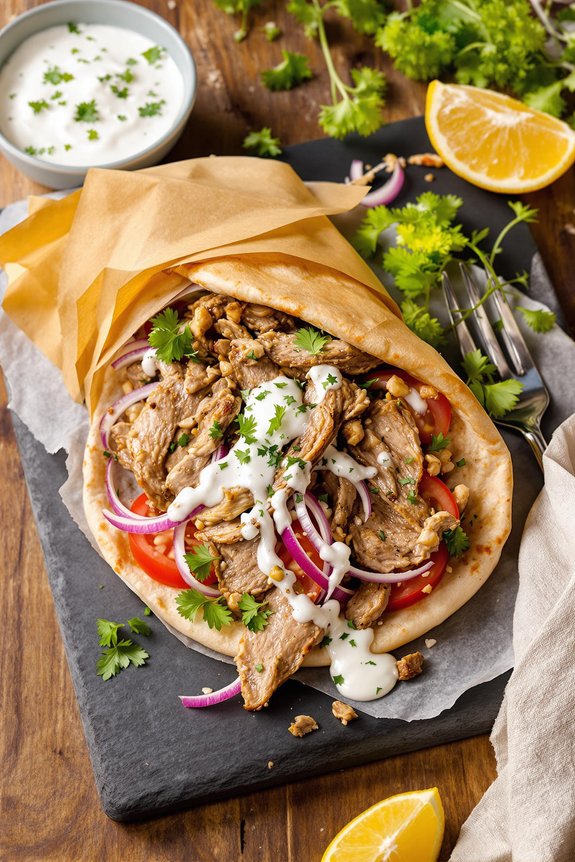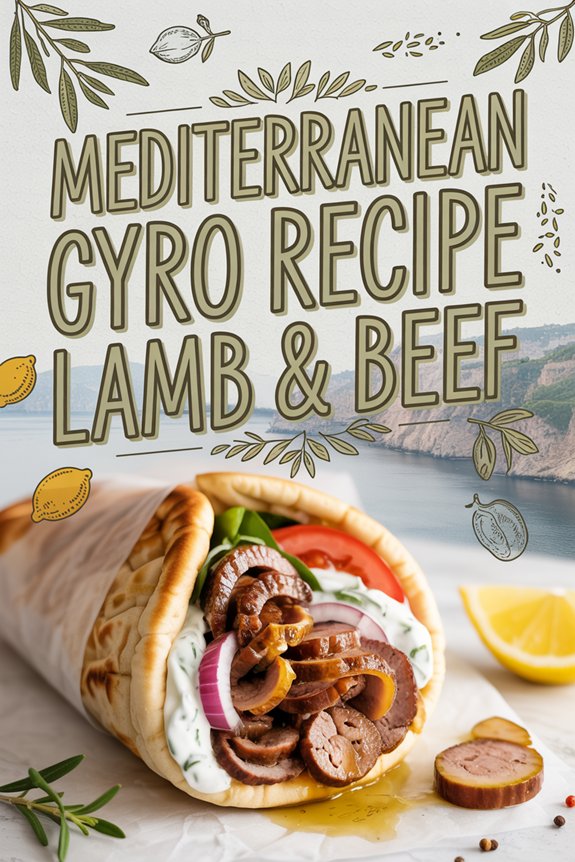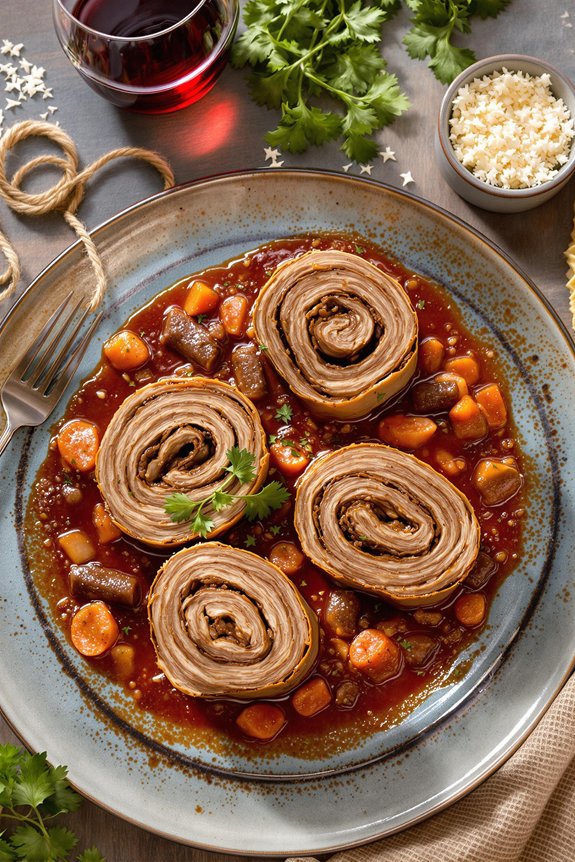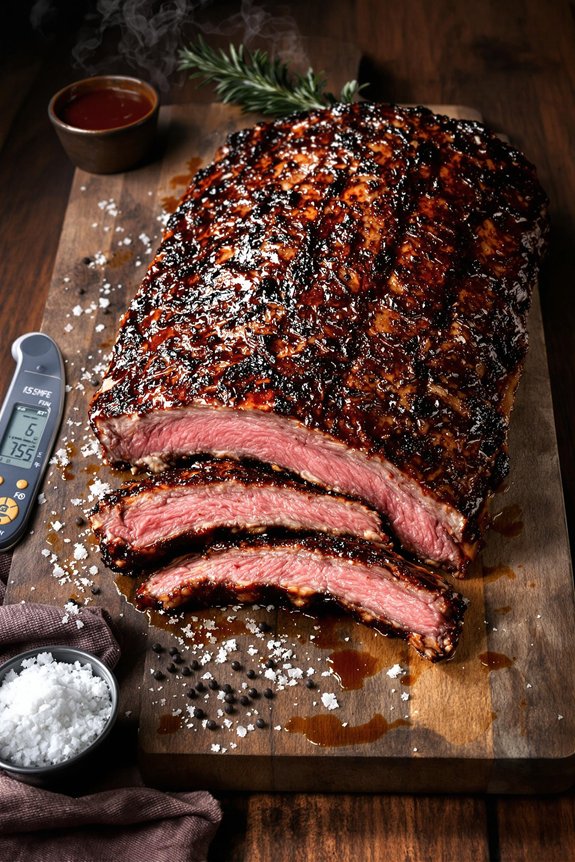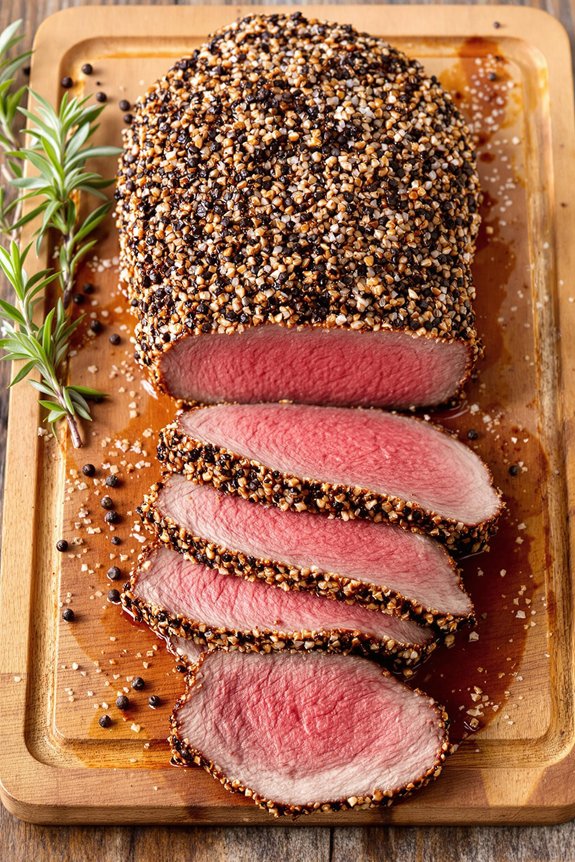Why You’ll Love these Mediterranean Gyros
Flavor explosion. These homemade gyros combine ground lamb and beef with a perfect blend of spices that’ll transport your taste buds straight to the Mediterranean.
I’m talking about oregano, cumin, and a hint of cinnamon that creates that authentic gyro flavor you crave. The slow-cooking process and overnight rest let all those gorgeous spices meld together, creating meat that’s tender, juicy, and incredibly aromatic.
And unlike restaurant versions that might use mystery meat, you’re in control of every ingredient. Serve it tucked into warm pita with cool tzatziki, and watch everyone at your table swoon.
What Ingredients are in Mediterranean Gyros?
The magic of homemade gyros lies in its perfect balance of meats and aromatic spices. Traditional Greek gyros typically use lamb, but this recipe combines lamb with beef for a more approachable flavor profile that still delivers authentic Mediterranean taste.
The spice mixture is where the real transformation happens—warming spices like cinnamon and cumin mingle with classic oregano and pepper to create that distinctive gyro flavor we all recognize from our favorite Mediterranean restaurants. When these ingredients compress overnight, they develop a firm texture that can be sliced paper-thin, just like the spinning vertical rotisseries you see in authentic gyro shops.
- 1½ pounds ground lamb
- 1 pound ground beef
- ¼ cup chopped onion
- ⅓ cup water
- 1 tablespoon salt
- 1 tablespoon sugar
- 2 teaspoons dried oregano
- 2 teaspoons coarsely ground black pepper
- 1 teaspoon ground cumin
- 1 teaspoon cayenne pepper
- ½ teaspoon cinnamon
- 2 garlic cloves, minced
- 2 teaspoons vegetable oil
- 8 slices bacon (for lining the pan)
- Pita bread (for serving)
When shopping for this recipe, quality matters, especially for the meat. Look for fresh ground lamb and beef with a decent fat content—around 15-20% fat will give you the juiciest results.
For a budget-friendly option, you could shift the ratio to use more beef than lamb, though you’ll sacrifice some of that distinctive flavor. The bacon might seem like an unusual addition, but it serves a dual purpose: it prevents the meat from sticking to the pan and adds a subtle smoky flavor to the exterior.
And while the recipe doesn’t specify it, you might want to pick up ingredients for the traditional accompaniments—tomatoes, onions, and yogurt for homemade tzatziki sauce—to create the complete gyro experience.
How to Make these Mediterranean Gyros
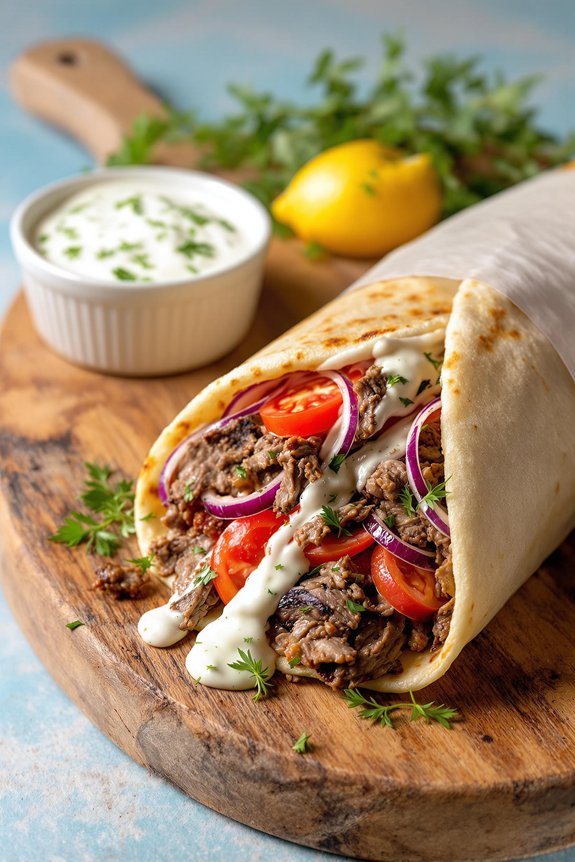
Making restaurant-quality gyros at home starts with a perfectly seasoned meat mixture. In a small bowl, combine 1 tablespoon salt, 2 teaspoons oregano, 2 teaspoons coarsely ground black pepper, 1 teaspoon cumin, 1 teaspoon cayenne pepper, and ½ teaspoon cinnamon, mixing thoroughly to create your signature gyro spice blend.
In a large bowl, combine 1½ pounds ground lamb and 1 pound ground beef with ¼ cup chopped onions and your spice mixture. Add 2 minced garlic cloves and 2 teaspoons vegetable oil, then roll up your sleeves and mix everything thoroughly with your hands until those beautiful spices are evenly distributed throughout the meat. This hands-on approach, while a bit messy, guarantees every bite will have that perfect gyro flavor.
Cover and refrigerate this mixture for several hours—the longer, the better, as the flavors need time to mingle and get acquainted.
Before committing to the full recipe, it’s smart to do a taste test. Heat a small skillet with a bit of butter and fry a small patty of your meat mixture. This little chef’s trick gives you a chance to adjust seasonings before proceeding.
Now for the magic that creates that dense, sliceable gyro texture: blanch 8 slices of bacon by simmering them in hot water for about 3 minutes, then drain on paper towels. Line an 8½ × 5 × 3-inch loaf pan with the bacon, covering both sides and bottom completely.
Pack your gyro meat firmly into the pan, right to the top, then cover with any remaining bacon slices. Place this filled pan into a hot water bath that comes about ¾ of the way up the sides, then bake at 375°F for 20-30 minutes before reducing the heat to 325°F for another 30 minutes. This gentle cooking method prevents the meat from becoming dry and keeps it juicy.
The final steps are vital for achieving that authentic gyro texture. Once baked, remove the pan from the water bath and place it on a wire rack to cool slightly. Cover with aluminum foil and—here’s the secret—place about 2 pounds of weight on top to compress the loaf.
This compression is what gives gyro meat its characteristic dense texture that allows for paper-thin slicing. Allow the meat to cool to room temperature, then refrigerate with the weight still on top for at least 12 hours or overnight. This resting period isn’t just for texture; it actually enhances the flavor considerably.
When you’re ready to serve, slice the meat as thinly as possible (a sharp knife makes all the difference here) and warm the slices before tucking them into soft pita bread with sliced onions, juicy tomatoes, and cool, creamy tzatziki sauce. For an authentic experience, consider using Mexican kitchen appliances to properly warm your pita bread and heat the sliced meat. One bite, and you might wonder why you ever ordered takeout.
Mediterranean Gyros Substitutions and Variations
While our traditional gyro recipe creates mouth-watering results, I’m a firm believer that cooking should adapt to your pantry and preferences.
Don’t have lamb? Try using all beef, or mix in ground turkey for a lighter option. Pork works beautifully too, lending a subtle sweetness to the mix.
For a vegetarian twist, crumbled firm tofu or a mushroom-walnut mixture can mimic that satisfying texture.
Spice-wise, feel free to adjust the heat level by reducing the cayenne, or add a Mediterranean flair with a pinch of sumac or za’atar.
Can’t find pita? Flatbreads, naan, or even lettuce wraps make worthy vessels for these aromatic slices.
What to Serve with Mediterranean Gyros
Perfect gyros deserve equally impressive accompaniments that complement those bold, aromatic flavors. I love serving mine with a cooling tzatziki sauce—that creamy cucumber-yogurt blend cuts through the richness of the meat perfectly.
A simple Greek salad with chunks of feta, juicy tomatoes, and kalamata olives makes an ideal side dish.
Don’t forget the carbs. Crispy homemade Greek potatoes seasoned with lemon and oregano? Yes, please.
Or try a light, lemony rice pilaf that soaks up any extra juices from your gyro.
Want to go all out? Add warm pita triangles and a small bowl of hummus for dipping. Mediterranean heaven on a plate.
Final Thoughts
As you master this Mediterranean gyro recipe, you’ll discover that homemade gyros can rival anything from your favorite Greek restaurant.
The magic happens in the spice blend—that perfect harmony of oregano, cumin, and cinnamon that transforms simple ground meats into something extraordinary.
I love how this recipe creates a firm, sliceable loaf that mimics traditional rotisserie gyro meat.
Can you imagine the look on your friends’ faces when you serve them restaurant-quality gyros from your own kitchen?
The overnight rest is non-negotiable, though—it’s what gives the meat that authentic depth of flavor.
Worth every minute of planning ahead.

